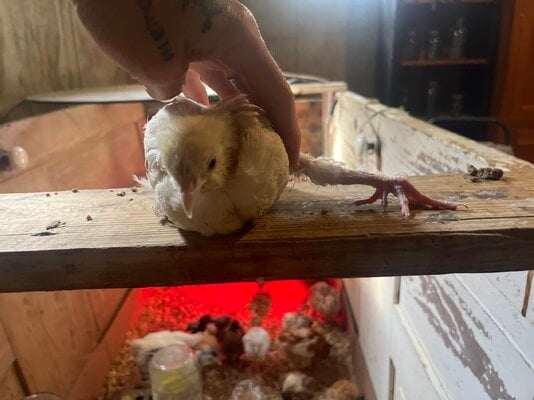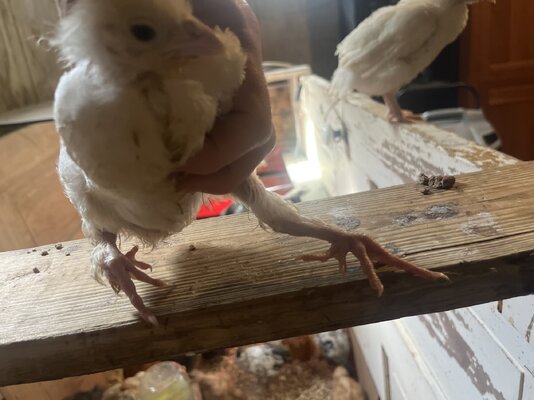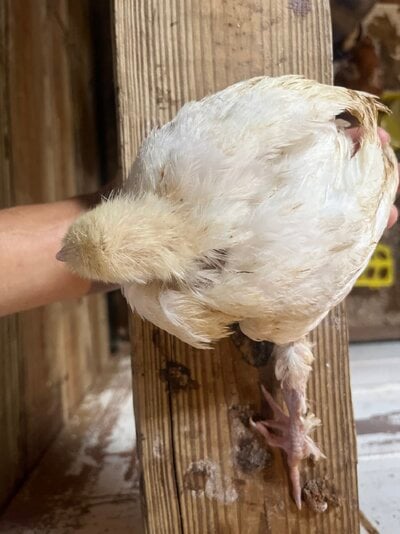We have been gifted many dozens of birds (about 150) recently by a girl who is getting out of the bird life. Within those numbers are 50 babies of various types including 6 or so salmon faverolles.
We had one end up sick a few days ago and her legs were all out of whack, almost like splayed leg. But they are around a month old and were fine when we got them. She couldn’t stand at all and I put her in a hospital tub and tried to do a splay leg wrap but I don’t think that’s what it was. In my experience when we’ve had little babies (few days old) with splay leg, they are usually able to move around better with the wrap, but she just fell over and eventually gave up on life.
So then yesterday I realized we have yet another faverolle that has the same leg issue. This one seems pretty healthy besides the legs. She scoots around the brooder and is eating and I’m helping to make sure she’s drinking (because we have the waterers up on a step stool within the brooder, with steps that lead up to it so they don’t bury the waterers in wood chips!). Anyways, I don’t know what to do- was thinking about trying to do a splay leg splint wrap but since they are four weeks old, I think their bones are set and fused in place (I don’t know that that is correct terminology).
I feel so so bad for her. Another thing is I noticed a few bloody poops in the brooder the other morning so I started them on corid two days ago. They all seemed fine other than this leg problem, but I don’t want to risk coccidiosis on all of these angels.
Just a few general things that may or may not be factors: we feed non gmo feed, when I got them (which was about two weeks ago) I started them on homemade apple cider vinegar in their water- they came from rural king, so likely a big hatchery and that’s what I was told by cackle to do the one time I ordered Guinea and they were a little weak. So I just do that with all of the babies now to strengthen their immune system. One another (very annoying factor) is that we realized one of our cats was getting in the brooder and peeing in it! It’s a huge brooder, like made out of old doors, but yeah he treated it like a giant litter box. I fully detailed it and dried the wet areas, etc like beyond normal changing of the wood chips clean. But it was very wet in there for a couple of days. I don’t know if the ammonia could be a factor in what is happening or not but figured I should mention it.
All of the other birds are fine. I think I’ve covered everything that could be of importance. I hope someone has some suggestions or past experience with something like this. I’ll throw up a couple of photos of her situation to give y’all an idea of what I’m working with.
Any replies will be appreciated! This is only my second post so any tips there are welcome as well!
-ren at fairly feathered farmstead
We had one end up sick a few days ago and her legs were all out of whack, almost like splayed leg. But they are around a month old and were fine when we got them. She couldn’t stand at all and I put her in a hospital tub and tried to do a splay leg wrap but I don’t think that’s what it was. In my experience when we’ve had little babies (few days old) with splay leg, they are usually able to move around better with the wrap, but she just fell over and eventually gave up on life.
So then yesterday I realized we have yet another faverolle that has the same leg issue. This one seems pretty healthy besides the legs. She scoots around the brooder and is eating and I’m helping to make sure she’s drinking (because we have the waterers up on a step stool within the brooder, with steps that lead up to it so they don’t bury the waterers in wood chips!). Anyways, I don’t know what to do- was thinking about trying to do a splay leg splint wrap but since they are four weeks old, I think their bones are set and fused in place (I don’t know that that is correct terminology).
I feel so so bad for her. Another thing is I noticed a few bloody poops in the brooder the other morning so I started them on corid two days ago. They all seemed fine other than this leg problem, but I don’t want to risk coccidiosis on all of these angels.
Just a few general things that may or may not be factors: we feed non gmo feed, when I got them (which was about two weeks ago) I started them on homemade apple cider vinegar in their water- they came from rural king, so likely a big hatchery and that’s what I was told by cackle to do the one time I ordered Guinea and they were a little weak. So I just do that with all of the babies now to strengthen their immune system. One another (very annoying factor) is that we realized one of our cats was getting in the brooder and peeing in it! It’s a huge brooder, like made out of old doors, but yeah he treated it like a giant litter box. I fully detailed it and dried the wet areas, etc like beyond normal changing of the wood chips clean. But it was very wet in there for a couple of days. I don’t know if the ammonia could be a factor in what is happening or not but figured I should mention it.
All of the other birds are fine. I think I’ve covered everything that could be of importance. I hope someone has some suggestions or past experience with something like this. I’ll throw up a couple of photos of her situation to give y’all an idea of what I’m working with.
Any replies will be appreciated! This is only my second post so any tips there are welcome as well!
-ren at fairly feathered farmstead






